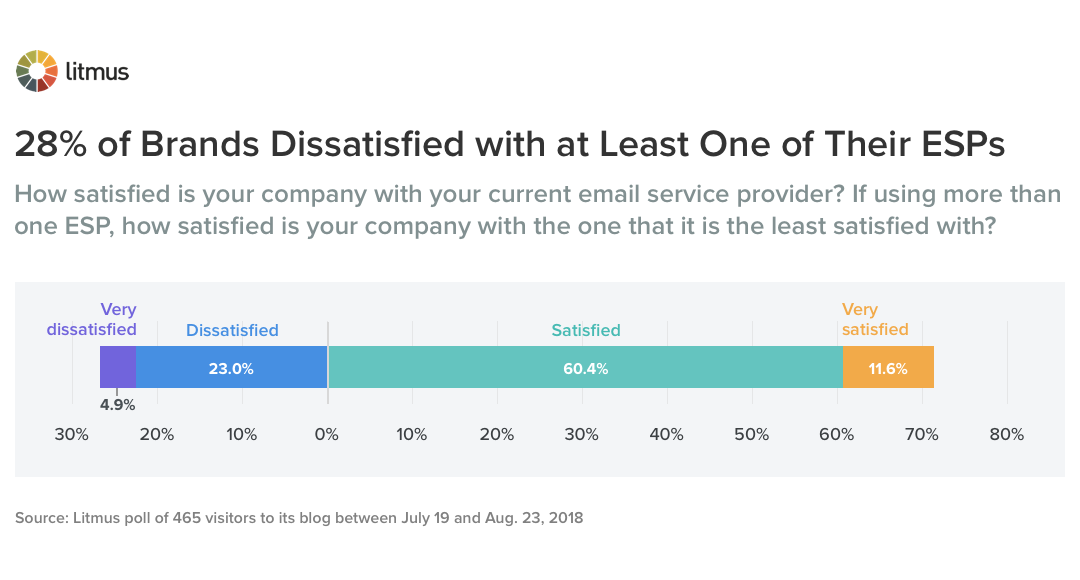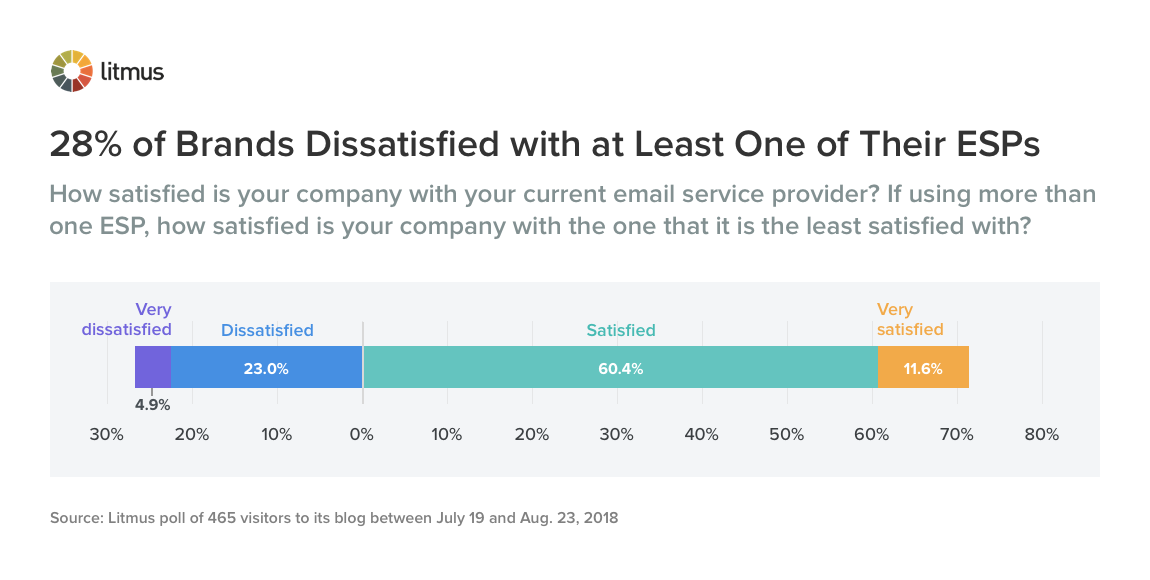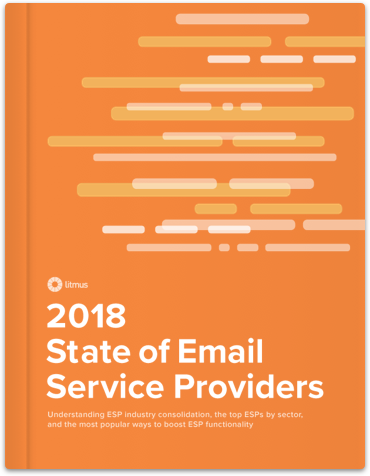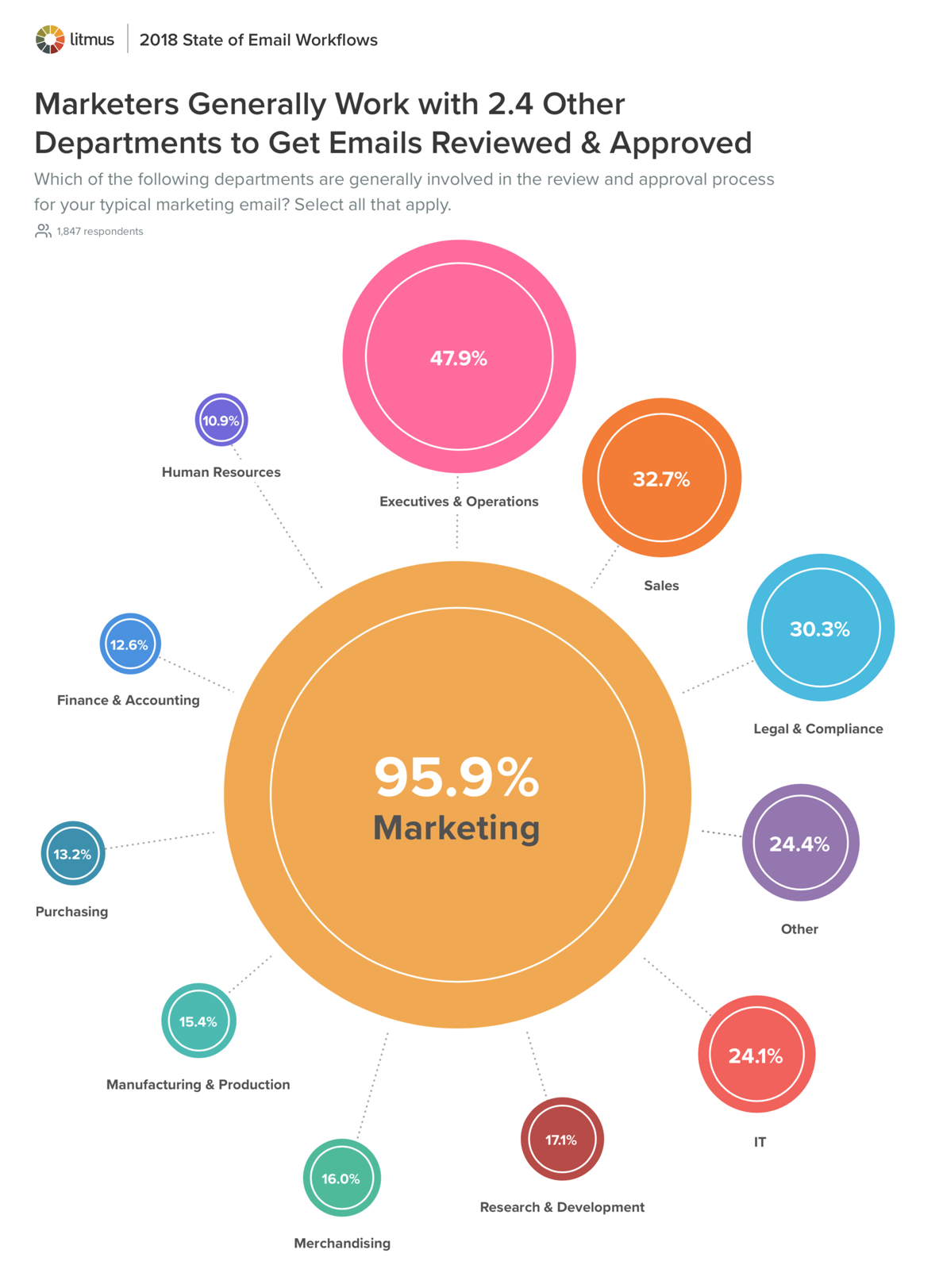Nearly 5% of brands are very dissatisfied with their email service provider, and another 23% are dissatisfied, according to a Litmus poll. Many of those brands might consider switching ESPs in the months ahead.
However, before any brand switches ESPs, they will likely write a request for proposal. A RFP is a list of questions you send to prospective vendors, whose answers you then compare to one another to differentiate their offerings and find the best fit for your brand’s needs.
But which ESP candidates should you include? How should your ESP RFP process go? What should you include in your RFP?
To answer those questions and more, Litmus reached out to email experts at Marketing Democracy, BrightWave Marketing, DEG, Trendline Interactive, emailvendorselection.com, Laughlin Constable, and Red Pill Email.
How long should the ESP RFP process take?
The consensus among our experts is that 6 months is the shortest amount of time to go from starting an RFP process to migration complete—and that doesn’t leave you much, if any, room for delays. They were much more comfortable with a 12-month runway till the end of your current ESP contract, especially for larger companies and ones with more integrations.
“A simple rule of thumb we tell clients is to estimate how long they think their RFP will take—and then double that,” says Chris Marriott, President & Founder of Marketing Democracy. [Tweet this →]
Lydia Mundie, Account Director at BrightWave Marketing, says, “It will most likely take 1-3 months for the RFP process to conclude (at an expedited pace), 2 months to identify and finalize the desired features and requirements of the new ESP (including that contract), and another 3 months to develop the migration plan and then successfully execute against that plan to officially make the switch.”
Be sure to give ESPs enough time to answer your questions. Don’t give them less than a week to respond to hundreds of questions, says Cara Olson, Director of Relationship Marketing at DEG.
“I see brands insert very aggressive timeline schedules in the RFP and then rarely follow them,” she says. “Reviewing the responses takes longer than they anticipate, and then scheduling the on-sites for presentations is sometimes requested in a week or less. If you really want a thoughtful response and killer presentation relevant to your business, allow more time. I also see a lot of RFPs issued in Q4, which is the worst time to issue an RFP in my opinion.”
Don’t underestimate the time it can take to make decisions, says Andrew Kordek, Chief Strategist & Co-founder at Trendline Interactive. “Brands should be prepared to spend 5 months in decision-making mode,” he says. “It might take 2.5 months just to gather the stakeholders in a room and ensure that the RFP is written correctly and succinctly for the vendor.”
That’s all the more reason to not be stingy when budgeting time for an ESP RFP. “We’ve seen timelines derailed because the brand person leading the RFP leaves mid-way through,” says Marriott, “or the team neglects to determine in advance the criteria for selecting the winner at the end of the process. So they end up lurching from RFP to endless meetings with vendors—and then analysis paralysis sets in.”
Which ESPs should I send RFPs to?
Brands have no shortage of ESPs from which to choose. Here’s a list of more than 240 ESPs used by the respondents to Litmus’ 2018 State of Email Survey. But how do you narrow down the list? Time to do some research.
Ask experts. “Ask your peers on LinkedIn for recommendations and you’ll get pulled in 20 different directions,” says Jordie van Rijn, founder of emailvendorselection.com. Instead, seek out industry experts, especially ones that know the ESP marketplace well.
“Work with your agency or another industry partner,” says Emily Hauptle, Digital Strategist at Laughlin Constable. “They have evaluated ESPs for other organizations, understand platforms and what they offer very well, and can help you understand what features actually matter to support your business objectives.”
Several of our experts mentioned the following sources of ESP intel:
- Forrester (Forrester Wave: Email Service Providers)
- Gartner, including G2Crowd.com (Best Email Marketing Software)
- The Relevancy Group (The Relevancy Ring: ESP Buyer’s Guide)
- Red Pill Email (Email Vendor Guides)
- EmailVendorSelection (Complete List of Email Service Providers)
Look at the ESPs your peers use. Many ESPs specialize in serving brands in particular verticals. In Litmus’ 2018 State of Email Service Providers report, we broke out the top 10 ESPs in several verticals—including retail, education, nonprofit, and tech—and saw a number of ESP rise up onto those lists.
“To narrow down the search, the brand will need to understand how each ESP is serving their vertical,” says John A. Caldwell, President of Red Pill Email. “Look at your particular brand and your competitors to start to weed out the ESP chaff.”
Ask users of the ESP. Once you have a list of potential ESP candidates, you can narrow it further by doing demos and speaking with customers.
“Industry events, like the Email Evolution Conference and the Email Innovation Summit, are great for exploring and hearing first-hand what other users think,” says Caldwell, who adds that you can often get hands-on demos at events.
Also, consider going to ESP events, says Rich Wilson, Vice President of CX at BrightWave Marketing. “Go to the ESP’s annual conference and network with existing customers to get first-hand information about what the tool’s actual strengths and weaknesses are directly from users.”
Who should be involved in my ESP RFP?
Marketing and IT are core to the process, but other departments should also be welcomed into the process.
“Brands would be amazed how the passive aggressive behaviors by others in an organization can totally derail an RFP,” says Marriott. “Leaving a department head outside the circle of trust in the RFP process almost always ensures that this person will do everything possible to thwart the process. This can be particularly disruptive if this person is in procurement or IT.
“Or maybe there’s a new senior hire in IT who has his or her heart set on building their own in-house email solution,” he adds. “Trust me, if you hire anyone from Amazon, this is guaranteed to happen. If you neglect to get everyone’s buy-in for your RFP plans, you will come regret it at some point in the process.”
In Litmus’ 2018 State of Email Workflows report, we discussed which departments were included in reviewing and approving emails. It’s probably a good starting point to include any department in the RFP process that’s involved on this level with your emails. Then look at the remaining departments that other brands include in their review processes and ask yourself if any of them should also have a hand in crafting your ESP RFP.
What questions should I ask in my ESP RFP?
We’re not going to dwell on the questions around capabilities, integrations, cost, and other factors that are surely already top of mind for you. Instead, we’re going to focus on some questions that might not be so obvious, but are nevertheless important.
Details please? In addition to asking the right questions, brands need to ask those questions the right way. Avoid asking yes/no questions that hurt your ability to identify material differences in their ability to meet your requirements, says Marriott.
“When the RFP focuses on simple yes or no answers to every question, everyone will say yes to everything,” he says. “It’s critical that questions are posed in a way that requires the vendors to provide some explanation. For example, is the ‘yes’ response to a certain requirement based on out-of-the box functionality, a custom solution, or a third-party integration?”
Services? Your RFP should be focused on platform capabilities, says Olson. Don’t muddy the waters by trying to evaluate services offerings at the same time.
“RFPs should be separate for platform and services,” she says. “Combining the two together doesn’t make sense. ESPs specialize in platform, not services.”
Support? “Ask about support service levels and how soon they will get back to you on an issue,” says Hauptle. “When you’re in the heat of getting a major campaign out the door, the last thing you want is an unresponsive customer support agent or unclear next steps to get the issue resolved.”
Data management? “Most RFPs don’t include enough information about data management and segmentation capabilities,” says Wilson. This may be a result of internal IT teams’ assuming they will do the work in-house or that they don’t understand that the tools they are evaluating may have those capabilities. RFPs may ask a lot about data connection points…but handling the data once in the tool may be missing.”
Migration success rate? Switching ESPs isn’t simple. Ask about the migration process, says Kordek. “How many successful migrations do they do a year similar to our companies size? How many people on the sales or migration team have actually worked client side? What is your client retention rate in the last 2 years on companies my size?”
Future-proof? Will the ESP have the capabilities that you’ll need in the years ahead? To ask the right questions here, you’ll need to ask some questions of yourself, says Caldwell.
“Ask yourself, How do I plan to position my brand in 5 years?” he says. “If you know where you’re heading, it’s easier to determine what you need from your ESP to help get you there.”
Kordek agrees. “Most companies want an ESP that they grow with, and not just the cheapest,” he says. Otherwise, you’re doing another ESP RFP process in just a few years. That’s definitely something that everyone wants to avoid.
Are they humble? Kordek also recommends asking some questions that give you an idea of how honest and self-aware an ESP is. “Ask: What do you guys suck at? He says. “What would your best client say about you and what would your worst client say about you?”
Marriott adds, “Brands need to remember that in the heat of a new business battle even the most professional ESP can fall back on a ‘win now, figure it out later’ strategy. By focusing on the right things and asking the right questions up front, brands can minimize the challenges any organization faces during the migration to a new vendor.”
Tell Us about Your ESP RFP Experience
Have you been involved in a request for proposal for a new email service provider? How did it go? What advice would you give others who are starting an ESP RFP? Let us know by joining the conversation about ESP RFPs in the Litmus Community.
Share your ESP RFP story →
The post Doing an ESP RFP: Improving Your Vendor Selection Process appeared first on Litmus Software, Inc..
![]()





